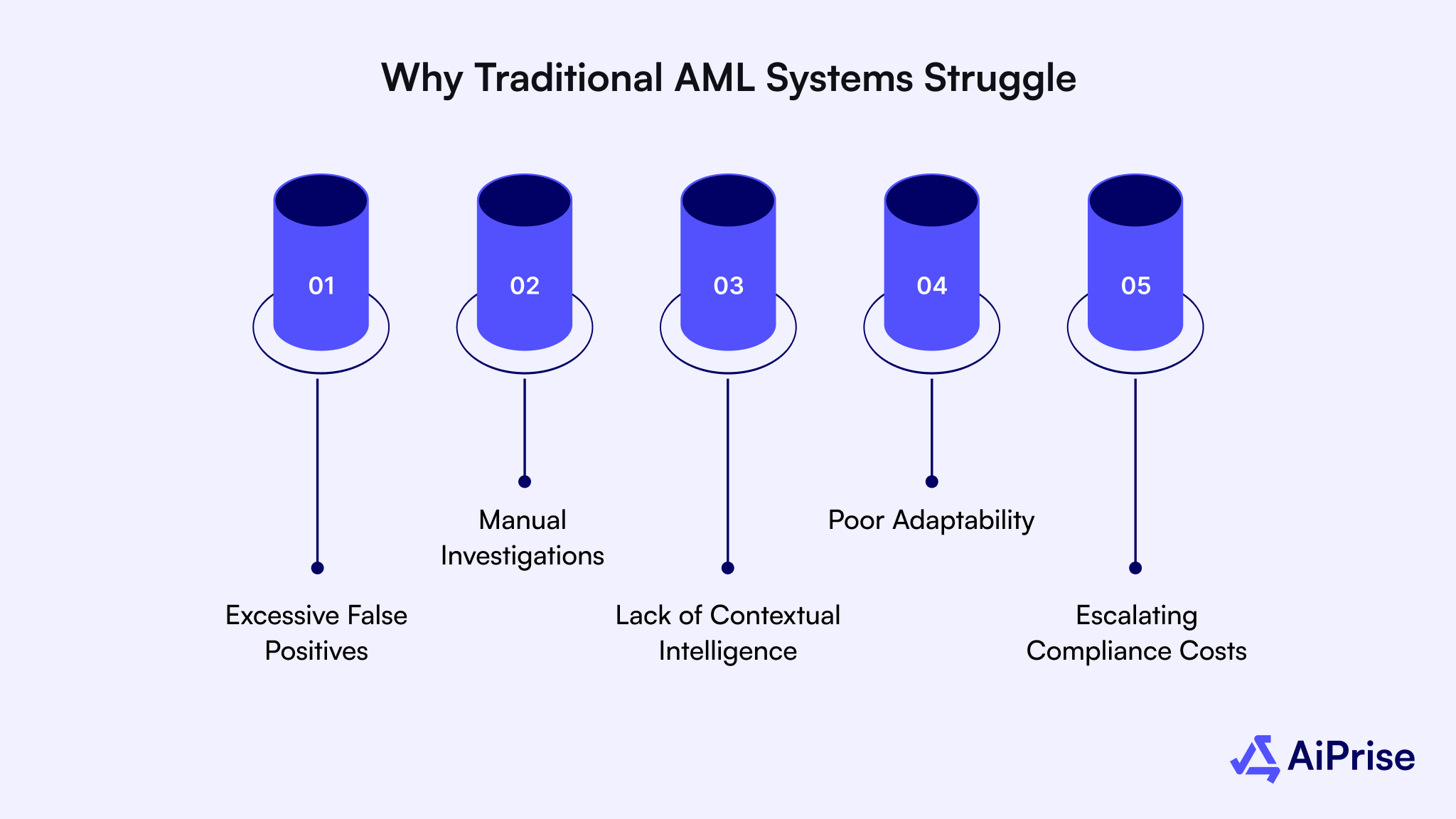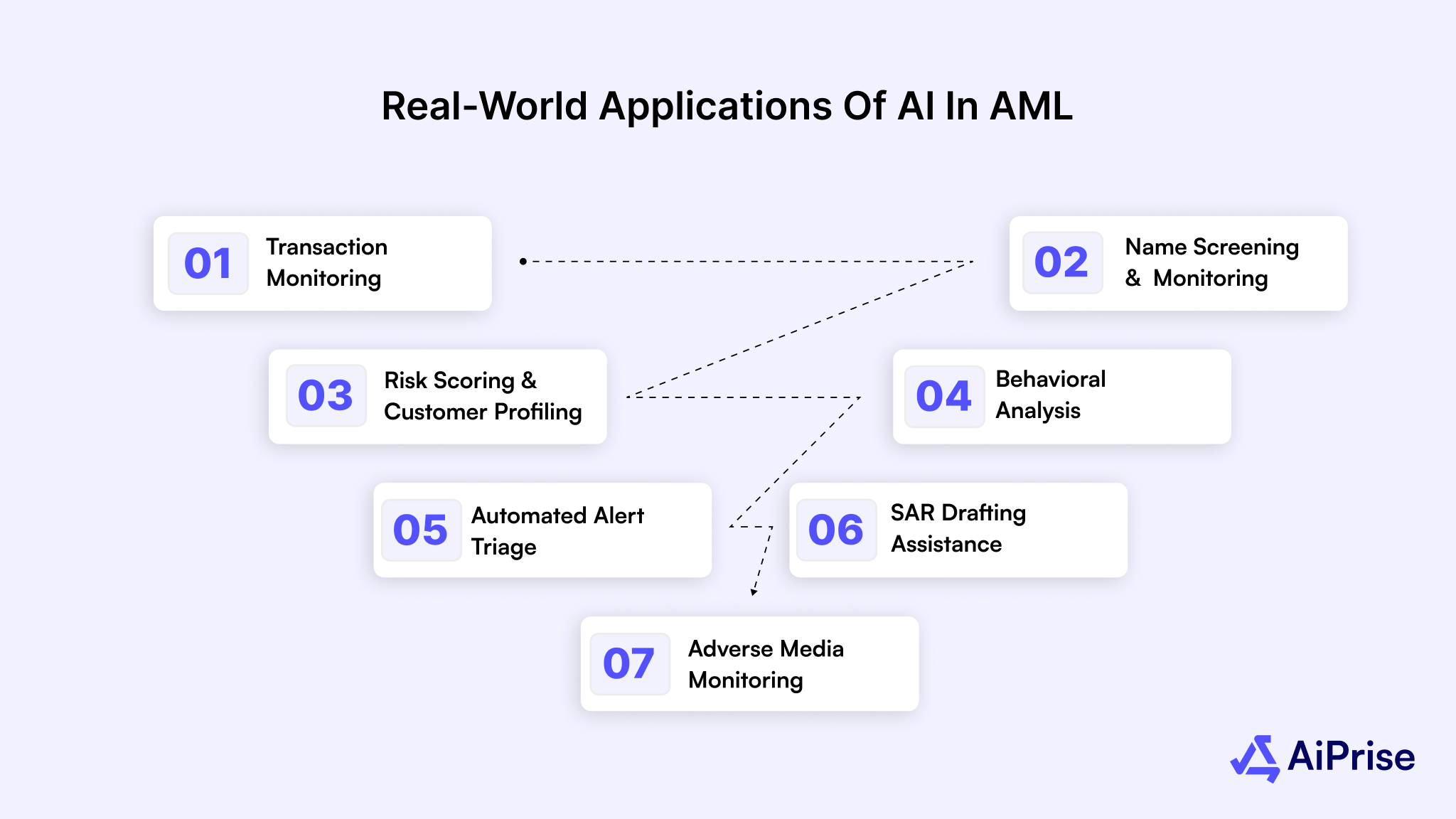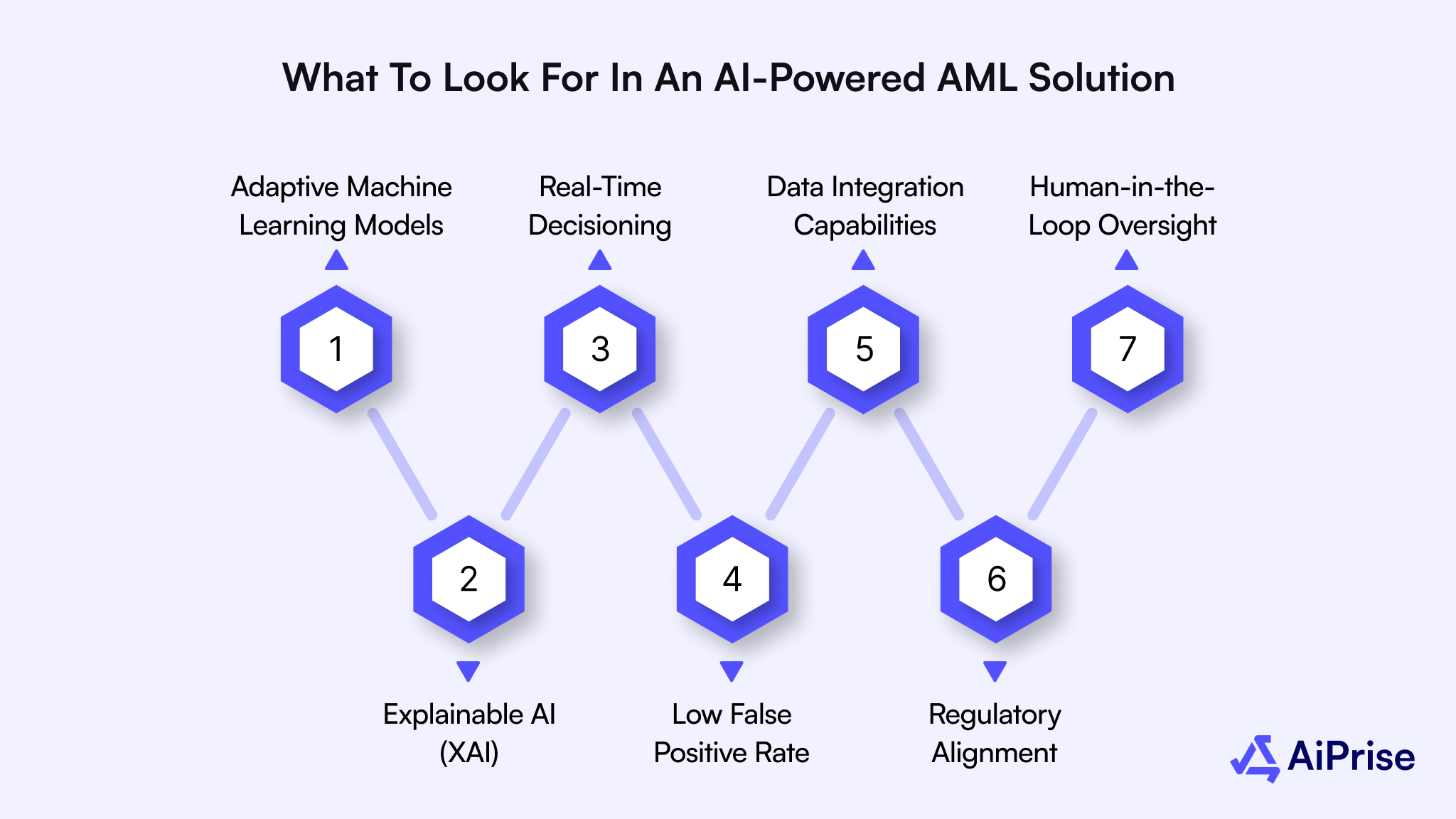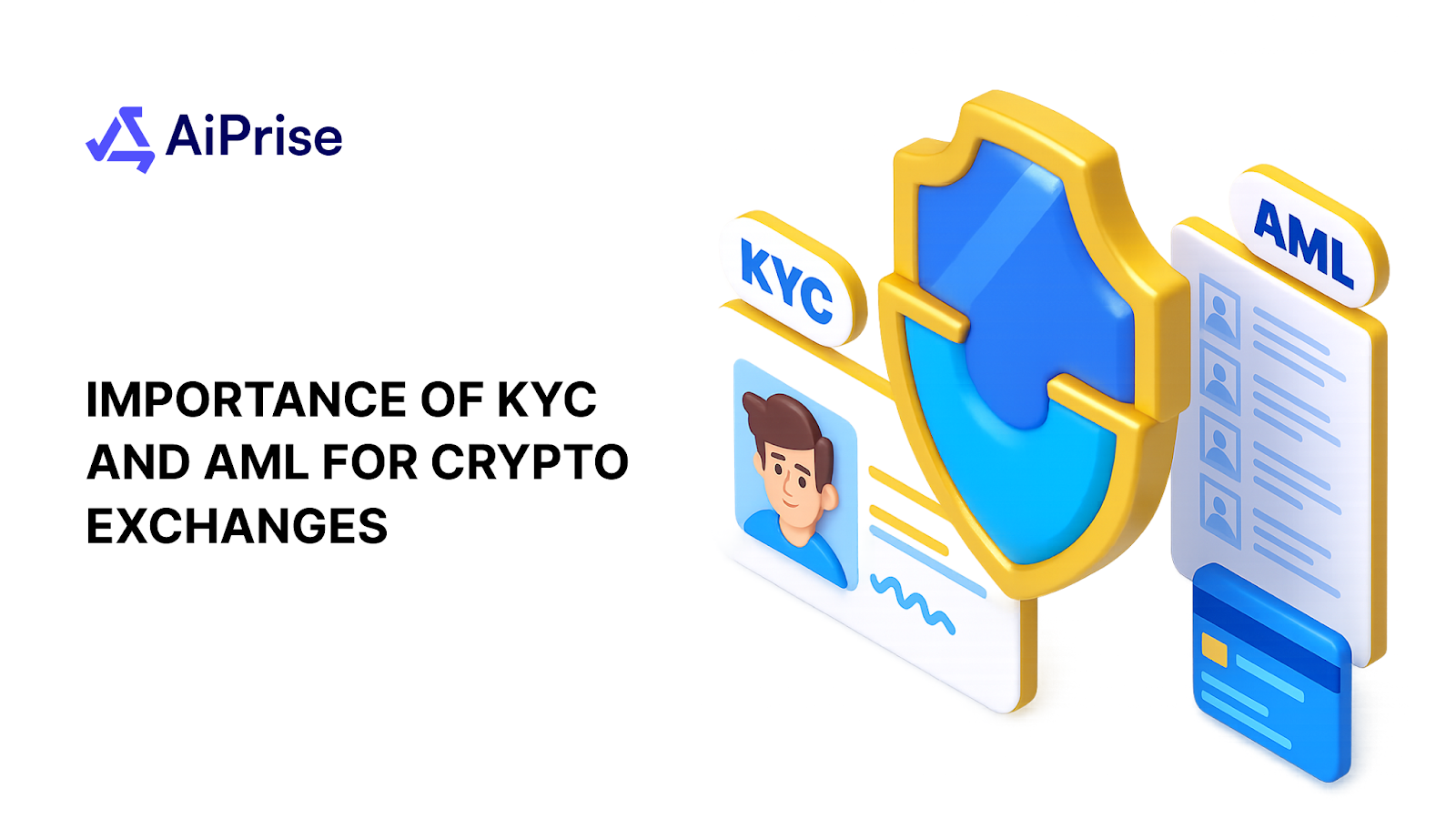AiPrise
8 min read
November 3, 2025
How AI is Transforming AML Compliance

Key Takeaways










As financial crime evolves, so do the methods used to fight it. Global regulators are tightening expectations, and financial institutions are processing more transactions than ever before. But legacy AML systems are struggling to keep up.
They flood compliance teams with false positives (up to 95% in many cases), require excessive manual review, and fail to detect newer, more complex laundering methods.
This is where AI AML compliance enters the picture and offers a faster, smarter, and more scalable way to combat money laundering.
In this blog, we’ll explore how AI is reshaping AML compliance, where it outperforms traditional systems, and what it means for the future of financial crime prevention.
In a View
- AI is transforming AML compliance by automating investigations, improving detection, and reducing manual workload.
- False positives can be reduced by up to 70%, helping analysts focus on real threats.
- AI enables faster case triage with investigations completed up to 50% quicker.
- Explainable AI is essential because regulators require transparency and auditability.
- The right solution must support data integration, human oversight, and regulatory compliance.
- AiPrise offers a complete AI-driven AML suite with real-time alerts, smart case management, and compliance automation.
Why Traditional AML Systems Struggle
Most legacy AML systems rely on rigid, rules-based engines. While they were designed to detect known patterns of suspicious activity, they often lack the flexibility to adapt to evolving money laundering tactics.
High-profile AML failures have resulted in billions in penalties, with TD Bank fined $3.09 billion in 2024 for systemic compliance failures and Danske Bank penalized $2.06 billion in 2022 for knowingly allowing suspicious transactions without filing proper reports.

Here’s where they fall short:
- Excessive False Positives
Traditional AML engines trigger alerts based on simple thresholds (e.g., transactions over $10,000). This leads to a false positive rate as high as 95%, forcing analysts to spend time reviewing legitimate transactions instead of real threats.
- Manual Investigations
Alerts must be reviewed, triaged, and investigated by compliance teams manually. This creates delays and increases the risk of missing genuine suspicious activity.
- Lack of Contextual Intelligence
Rules-based systems don’t consider customer behavior patterns, historical activity, or real-time risk signals. They treat every transaction in isolation.
- Poor Adaptability
Criminals constantly change techniques. Traditional systems must be manually updated to catch new tactics — often only after damage has been done.
- Escalating Compliance Costs
As regulatory scrutiny grows, financial institutions are spending more on compliance teams and external audits to make up for outdated systems.
These challenges have led to a shift toward intelligent, learning-based systems. Let’s define what AI AML compliance actually means and how it’s different from traditional approaches.
Suggested read: Understanding Anti Money Laundering Policies and Their Importance.
What Is AI AML Compliance?
Artificial intelligence technologies like machine learning, natural language processing, and pattern recognition are employed in AI AML compliance. The purpose of this application is to improve the detection, investigation, and reporting of suspicious financial activity.
Unlike traditional systems that rely solely on static rules, AI-enabled platforms learn from historical data and continuously adapt to new patterns of money laundering.
Key Capabilities of AI in AML:
- Machine Learning Models: Trained on past alerts and investigations to predict which cases are likely to be true positives.
- Behavioral Analytics: Understands customer habits and flags only unusual or high-risk activity.
- Natural Language Processing (NLP): Extracts insights from unstructured data like adverse media, notes, and case files.
- Real-Time Decisioning: AI can evaluate hundreds of risk factors in milliseconds — far faster than human review.
Rules-Based vs AI-Driven AML
With a clearer picture of what AI AML compliance looks like, let’s explore the most common and impactful ways AI is being applied in today’s AML programs.
Also read: Understanding Customer Screening for AML Compliance
How AI Is Used in AML Compliance
AI is transforming every step of the anti-money laundering process. This change covers everything from detection to decision-making. By automating analysis and applying intelligence at scale, AI reduces delays and improves accuracy across the board.
Here are the most common and impactful use cases of AI AML compliance:
Real-World Applications of AI in AML:

- Transaction Monitoring
AI analyzes historical and real-time transactions to identify unusual patterns. Unlike rule-based systems, it can spot subtle deviations in behavior that might indicate layering or structuring.
- Name Screening & Sanctions Monitoring
Natural language processing (NLP) improves fuzzy matching for sanctions, PEPs, and watchlists. AI reduces false positives caused by name variants, transliteration errors, or typos.
- Risk Scoring & Customer Profiling
AI creates dynamic risk scores based on behavior, geography, transaction type, and peer group comparisons — not just static attributes like occupation or nationality.
- Behavioral Analysis
Machine learning models flag customers who suddenly change their transaction frequency, location, or counterparties, which are potential red flags for account takeover or money mule activity.
- Automated Alert Triage
AI classifies alerts by severity and recommends next actions based on prior case outcomes. Low-risk alerts may be auto-closed, allowing analysts to focus on high-risk ones.
- SAR Drafting Assistance
Generative AI and NLP can summarize case details and suggest Suspicious Activity Report (SAR) language, reducing the documentation burden on analysts.
- Adverse Media Monitoring
AI continuously scans global news sources for mentions of individuals or entities under review, adding an extra layer of risk intelligence.
Beyond enhancing individual tasks, AI fundamentally improves how compliance teams operate. Let’s compare how AI stacks up against traditional AML systems.
Benefits of AI in AML Compliance
AI is fundamentally redefining how AML teams operate. From reducing false positives to accelerating investigations, the operational benefits are both measurable and strategic.
Here’s how AI AML compliance compares with traditional methods:
Comparison Table: Traditional vs AI-Powered AML
And it’s not just theory — the results are being observed across industries:
- Financial institutions using AI have reported up to 60% faster alert triage, thanks to automated prioritization.
- Investigation time per case has dropped by half, with enriched profiles and contextual scoring built in.
- AI has significantly enhanced high-risk case detection, with some institutions reporting a 3–5× increase in risk identification and up to 70% fewer false positives.
- On a broader scale, this shift is expected to deliver over $3 billion in annual compliance savings globally.
In short, AI isn’t replacing human decision-makers — it’s giving them better tools to act faster, with higher precision, and greater regulatory confidence.
So, if you're evaluating AI for your compliance operations, what exactly should you look for in a next-gen AML platform?
Also read: Understanding The Five Pillars Of An AML Compliance Program
What to Look for in an AI-Powered AML Solution
As more compliance teams explore AI-driven tools, the challenge now is choosing the right solution. Not every platform that claims to be “AI-powered” actually delivers value.

Here’s what matters most when evaluating a system built for AI AML compliance:
- Adaptive Machine Learning Models
Look for platforms that learn from outcomes and improve over time. Beware of platforms that only use pre-set rules and repackage them as “intelligent" models. Ensure the model you opt for adjusts based on new threats, geography, and customer behavior.
- Explainable AI (XAI)
Compliance teams must justify why a case was flagged or cleared. The AI system should offer clear, auditable reasoning — not just a score or black-box outcome.
- Real-Time Decisioning
AI should operate at transaction speed while offering real-time scoring, alerts, and risk updates to prevent delays in review and escalation.
- Low False Positive Rate
The best platforms demonstrate measurable improvements in alert quality. Ask for proof: Does the system reduce false positives by 40% or more?
- Data Integration Capabilities
A modern AML platform must ingest data from transaction monitoring, KYC, sanctions screening, and adverse media — unifying everything into one investigative dashboard.
- Regulatory Alignment
Any AI AML tool must align with global regulations (FATF, FinCEN, EU AMLD), offering audit-ready logs and documentation capabilities for SAR/STR filings.
- Human-in-the-Loop Oversight
While automation is essential, the ability for analysts to override, retrain, or comment on AI decisions ensures better accuracy and control.
The future of AML is intelligent, and only the right partner can add that intelligence to your growing business.
How AiPrise Helps Businesses Drive AI-Powered AML Compliance
As regulatory demands grow and financial crime becomes more complex, AiPrise equips compliance teams with the tools they need to stay ahead. Built for scale, speed, and precision, AiPrise brings together AI, automation, and compliance intelligence — all in one unified platform.
Key AiPrise Capabilities That Support AML Compliance:
- Real-Time Suspicious Activity Monitoring
Ai-powered systems flag high-risk transactions instantly, allowing teams to act before exposure increases. Suspicious Activity Reports (SARs) can be filed faster and with greater context.
- Built-In Case Management
AiPrise offers a dedicated case management system that tracks the full lifecycle of suspicious activity — from alert to resolution — with clear audit trails and workflow automation.
- Global Watchlist Screening
Customers and transactions are continuously checked against global sanctions lists, PEPs, and adverse media to identify risk early in the customer journey.
- One-Click KYC & Onboarding SDK
AiPrise simplifies verification with a one-click KYC process, and developers can easily integrate it using the onboarding SDK — ensuring compliance from the first interaction.
- Automated Compliance Workflows
Customize workflows to match internal policies and regulatory guidelines. AiPrise reduces manual steps, minimizes errors, and ensures consistency across every case.
- Document Intelligence
Advanced document verification and extraction ensure authenticity and reduce identity fraud risk — helping analysts process cases faster.
- Compliance Copilot (AI Assistant)
AiPrise’s AI-powered assistant automates rule checks, suggests next steps, and can reduce review times by up to 95%, speeding up investigations without sacrificing accuracy.
With these tools, AiPrise enables businesses to confidently manage growing compliance demands while minimizing operational fatigue and risk exposure.
Conclusion
AI has become a critical driver of transformation in AML compliance. It is no longer optional, but essential for staying ahead of financial crime and regulatory pressure.
From real-time risk monitoring and false positive reduction to intelligent case management, the shift to AI AML compliance is already reshaping how leading institutions protect their businesses.
Ready to Future-Proof Your Compliance Program?
Book a Demo with AiPrise to see how our AI-powered compliance suite can streamline investigations, reduce manual work, and keep you aligned with global regulations. You'll see the benefits from day one.
Frequently Asked Questions (FAQs)
Q1. How is AI used in AML compliance?
AI is used to detect suspicious patterns in transactions, reduce false positives, prioritize high-risk alerts, and automate parts of the investigation process. It enhances speed, accuracy, and audit readiness in AML compliance.
Q2. What are the benefits of using AI in AML?
AI improves alert quality, reduces manual workload, detects hidden fraud patterns, and enables faster decision-making. It also lowers compliance costs and improves case resolution timelines.
Q3. Can AI completely replace human analysts in AML?
No. AI supports analysts by automating repetitive tasks and flagging risks, but human oversight is essential for final decisions, regulatory interpretation, and nuanced cases.
Q4. How does AI reduce false positives in AML systems?
AI models learn from past case outcomes and customer behavior to better distinguish between legitimate and suspicious activity — reducing false positives by up to 70%.
Q5. Is AI AML compliance accepted by regulators?
Yes. While regulators require transparency, many now support AI use in AML as long as it is explainable, auditable, and aligns with frameworks like FATF, FinCEN, and GDPR.
You might want to read these...

Aiprise has helped streamline our KYB (Know Your Business) flow in 100+ countries. No other tool comes close.





Speed Up Your Compliance by 10x
Automate your compliance processes with AiPrise and focus on growing your business.





























